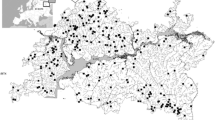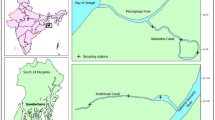Abstract
In this work, we examined water-quality assessment in relation to fish assemblage of Gomti River, a large tributary of the Ganges River basin in northern India. Principal component analysis was performed for 18 environmental variables which produced three axes that cumulatively explained 60.23% of the environmental variation in sites. Fifteen variables (fine substrate fine gravel, coarse gravel, cobble, sand substrate water flow, conductivity, TDS, total hardness, temperature, dissolved oxygen, pH, and overhanging vegetation) had high loadings on at least one of the principal component axes interpreted. The canonical correspondence analysis was used to establish the relationship between important fish species and environmental variables. Species were distributed within four groups with respect to the significant habitat characteristics. The Pearson correlation coefficient was calculated between the water-quality parameters. We concluded that the level of species richness is mostly dependent on abiotic factors like temperature, dissolved oxygen, TDS, conductivity, depth, pH, and water current in the Gomti River, of the Ganges basin.



Similar content being viewed by others
References
Aadland LP (1993) Stream habitat types: their fish assemblages and relationship to flow. North Am J Fish Manag 13:790–806
Angermeier PL, Schlosser IJ (1989) Species area relationship for stream fishes. Ecology 70:1450–1462
APHA (1998) Standard methods for the examination of water and wastewater, 18th edn. American Public Health Association, American Water Works Association, and Water Pollution Control Federation, Washington, DC, p 959
Arunachalam M (2000) Assemblage structure of stream fishes in the Western Ghats (India). Hydrobiologia 430:1–31
Arunachalam M, Madhusoodanan NKC, Vijverberg J, Kortmulder K (1988) Food and habitat usage of cyprinid fish assemblage in stream pools of a south Indian River. Rep. 19, Limnological Institute of the Royal Academy of Sciences. The Netherlands, p 89
Bain MB (1995) Habitat at the local scale: multivariate patterns for stream fishes. Bulletin Français de la Pêche et la Pisciculture 337/338/339:165–177
Bain MB, Knight JG (1996) Classifying stream habitat using fish community analysis. In: Leclerc M, Capra H, Valentin S, Boudreault A, Coˆte′ Y (eds) Proceedings of the second IAHR symposium on habitat hydraulics, Ecohydraulics 2000. Institute National de la Recherche Scientifique-Eau, Ste-Foy, Quebec, Canada, pp 107–117
Bain MB, Stevenson NJ (1999) Aquatic habitat assessment: common methods. American Fisheries Society Bethesda, MD, p 216
Baird IG, Flaherty MS (2005) Mekong River fish conservation zones in southern Laos: assessing effectiveness using local ecological knowledge. Environ Manage 36:439–454
Barbour MT, Stribling JB, Gerritsen J, Karr JR (1996) Biological criteria. Technical guidance for streams and small rivers. Revised edition. In: Gibson GR Jr (ed) Environmental Protection Agency, 822-B-96-001, pp 162
Batcha ASM (1998) Studies on hydrography and domestic pollution problems in the north bank of river Cauvery. J Environ Pollut 5:69–71
Bhandari NS, Nayal K (2008) Correlation study on physico-chemical parameters and quality assessment of Kosi River Water, Uttarakhand. E-J Chem 5(2):342–346
Brown LR (2000) Fish communities and their associations with environmental variability in the lower San Joaquin River drainage, California. Environ Biol Fish 57:251–269
Carter MG, Copp GH, Szomlai V (2004) Seasonal abundance and microhabitat use of bullhead Cottus gobio and accompanying fish species in the River Avon (Hampshire), and implications for conservation. Aquat Conserv Marine Freshw Ecosyst 14:395–412
Chatfield C, Collins AJ (1980) Introduction to multivariate analysis. Chapman and Hall, London, p 248
Chhatawal GR (1998) Encyclopedia of environmental biology, vol 2. Anmol Pub. Pvt. Ltd., New Delhi, pp 287–301
Copp GH, Guti G, Rovny J (1994) Hierarchical analysis of habitat use by 0+ juvenile fish in Hungarian/Slovak flood plain of the Danube River. Environ Biol Fish 40:329–348
Fakayode SO (2005) Impact assessment of industrial effluent on water quality of the receiving Alaro River in Ibadan, Nigeria. Ajeam-Ragee 10:1–13
Garner P (1996) Microhabitat use and diet of 0+ cyprinid fish in a lentic, regulated reach of the river Great Ouse. J Fish Biol 48:367–382
Gorman OT, Karr JR (1978) Habitat structure and stream fish communities. Ecology 59:507–515
Gupta LP, Subramanian V (1994) Environmental geochemistry of the River Gomti, a tributary of the Ganges River. Env Geol 24:235–243
Hankin DG (1984) Multistage sampling designs in fisheries research: applications in small streams. Can J Fish Aquat Sci 41:1575–1591
Hayes DB, Ferreri CP, Taylor WW (2006) Linking fish habitat to their population dynamics. Can J Fish Aquat Sci 53:383–390
Hiware CJ, Jadhav BV (2001) Biological studies of Manjar River near Kallam, district Osmanabad, Maharastra, India. J Aquac Biol 16:11–13
Huet M (1986) Text book of fish culture, 2nd edn. Fishing News Book Ltd., England
Jayaram KC (1981) The freshwater fishes of India, Pakistan, Bangladesh, Burma, Sri Lanka. A Handbook Zoological of India, Calcutta, p 475
Jhingran VG (1975) Fish and fisheries of India. Hindustan Publishing Corporation, New Delhi, p 954
Karr JR, Fausch KD, Angermeier PL, Yant PR, Schlosser IJ (1986) Assessing biological integrity in running waters: a method and its rationale. III. Natural History Survey. Spec. Pub. 5. Champaign
Khan IA, Khan AA (1985) Physical and chemical condition in Seika Jheelat, Aligarh. Ecology 3:269–274
Kosygin L, Dhamendra H (2009) Physicochemical and biological characteristics of Awang Khujairok river, Manipur, India. Environ Ecol 27(1):82–85
Kovach WL (1999) MVSP – a multivariate statistical package for windows, ver. 3.1. Kovach Computing Services, Pentraeth, Wales, Great Britain
Lakra WS, Sarkar UK, Gopalakrishnan A, Pandian AK (2010) Threatened freshwater fishes of India. NBFGR publication, Lucknow
Lamouroux N, Souchon Y (2002) Simple predictions of in stream habitat model outputs for fish habitat guilds in large streams. Freshw Biol 47:1531–1542
Lamouroux N, Olivier JM, Persat H, Pouilly M, Souchon Y, Statzner B (1999) Predicting community characteristics from habitat conditions: fluvial fish and hydraulics. Freshw Biol 42:673–687
Lazorchak JM, Klemm DL, Peck DV (1998) Environmental monitoring and assessment program surface waters: field operations and methods for measuring the ecological condition of wadeable streams. U.S. Environmental Protection Agency, Washington, DC, EPA/620/R-94/004F
Leonard LC (1971) Water and water pollution, vol 1. Marcel Dekker, Inc., New York, pp 256–263
Lobb MD III, Orth DJ (1991) Habitat use by an assemblage of fish in a large warm water stream. Trans Am Fish Soc 120:65–78
Meitei NS, Bhargava V, Patil PM (2004) Water quality of Purna River in Purna town, Maharastra state. J Aquat Biol 19:77–78
Mohamed SMA (1998) Nutrient balance pattern in African livestock system. Agric Ecol Environ 71:241–254
Nath D, Srivastava NP (2001) Physico-chemical characteristics of Narmada for the stretch Sandia to Mola in M.P. state in the context of construction of reservoirs on the river or its tributaries. J Inland Fish Soc India 33:17–24
Newson MD, Newson CL (2000) Geomorphology, ecology and river channel habitat: mesoscale approaches to basin-scale challenges. Prog Phys Geogr 24:195–217
Odum EP (1971) Fundamentals of ecology, 3rd edn. Toppan Company, Ltd., Japan, pp 278–284
Ozaki M, Takahara T, Kawahara Y, Wada A, Seno K, Amakawa T, Yamaoka R, Nakamura T (2003) Perception of noxious compounds by contact chemoreceptor of the blowfly, Phormia regina: putative role of an odorant-binding protein. Chem Senses 28:349–359
Prasad NR, Patil JM (2008) A study of physico-chemical parameters of Krishna River water particularly in Western Maharashtra. Rasayan J Chem 1(4):943–958
Rafeeq MA, Khan AM (2002) Impact of sugar mill effluents on the water quality of the river Godavari near Kandakurthi village, Nizamabad district, Andhra Pradesh. J Aquat Biol 17:33–35
Raven JC, Styles I, Raven MA (1998) Raven’s progressive matrices: SPM plus test booklet. Oxford Psychologists Press, Oxford
Revenga C, Murray S, Abramovitz J, Hammond A (1998) Watersheds of the World: ecological value and vulnerability. World Resources Institute, Washington, DC. http://earthtrends.wri.org/maps_spatial/maps_detail_static.cfm?map_select=350&theme=2
Saksena DN, Garg RK, Rao RJ (2008) Water quality and pollution status of Chambal River in National Chambal sanctuary, Madhya Pradesh. J Environ Biol 29(5):701–710
Sarkar UK, Bain MB (2007) Priority habitats for the conservation of large river fishes in the Ganges river basin. Aquat Conserv Marine Freshw Ecosyst 17:349–359
Sarkar UK, Gupta BK, Lakra WS (2010) Biodiversity, ecohydrology, threat status and conservation priority of the freshwater fishes of river Gomti, a tributary of river Ganga (India). Environ 30(1):3–17
Sarkar UK, Pathak AK, Sinha RK, Sivakumar K, Pandian AK, Pandey A, Dubey VK, Lakra WS (2011) Freshwater fish biodiversity in the River Ganga (India): changing pattern, threats and conservation perspectives. Rev Fish Biol Fish. doi:10.1007/s11160-011-9218-6
Sheldon AL (1968) Species diversity and longitudinal succession in stream fishes. Ecology 49:194–198
Shrivastava VS, Patil PR (2002) Tapti river water pollution by industrial wastes: a statistical approach. Nat Environ Pollut Tech 1:279–283
Singh BN, Rai S (1999) Physico-chemical studies of Ganga river at Varanasi. J Environ Pollut 6:43–46
Singh HP, Mahaver LR, Mishra JP (1999) Limnochemical characteristics of river Ghaghara in U.P. J Inland Fish Soc India 31:28–32
Singh KP, Malik A, Mohan D, Sinha S (2004) Multivariate statistical techniques for the evaluation of spatial and temporal variations in water quality of Gomti River (India)—a case study. Water Res 38:3980–3992
Singh VK, Singh KP, Mohan D (2005) Status of heavy metals in water and bed sediments of river Gomti—a tributary of the Ganga River, India. Environ Monit Assess 105:43–67
Talwar PK, Jhingran A (1991) Inland fishes of India and adjacent countries. Oxford and IBH, New Delhi
Taylor CM, Winston MR, Matthews WJ (1993) Fish species environment and abundance relationships in a Great Plains river system. Ecography 16:16–23
Ter Braak CJF (1986) Canonical correspondence analysis: a new eigenvector technique for multivariate direct gradient analysis. Ecology 67:1167–1179
TerBraak CJF, Smilauer P (2002) Canoco reference manual and CanoDraw for Windows user’s guide: software for canonical community ordination, version 4.5. Microcomputer Power, Ithaca
Trivedi P, Bajpai A, Thareja S (2009) Evaluation of water quality: physico–chemical characteristics of Ganga River at Kanpur by using correlation study. Nat Sci 1(6):91–94
WHO (1993) World Health Organization, guidelines for drinking water quality-I, recommendations, 2nd edn. Geneva WHO, http://www.lenntech.com/drinking-water-standards.htm
Acknowledgments
We express sincere thanks to Dr W. S. Lakra, former Director, NBFGR and Dr J. K. Jena, Director, NBFGR, Lucknow for providing necessary facilities. This study was supported financially by the Council of Science and Technology, Government of Uttar Pradesh, Lucknow (CSTUP).
Author information
Authors and Affiliations
Corresponding author
Rights and permissions
About this article
Cite this article
Gupta, B.K., Sarkar, U.K. & Bhardwaj, S.K. Assessment of habitat quality with relation to fish assemblages in an impacted river of the Ganges basin, northern India. Environmentalist 32, 35–47 (2012). https://doi.org/10.1007/s10669-011-9363-4
Published:
Issue Date:
DOI: https://doi.org/10.1007/s10669-011-9363-4




